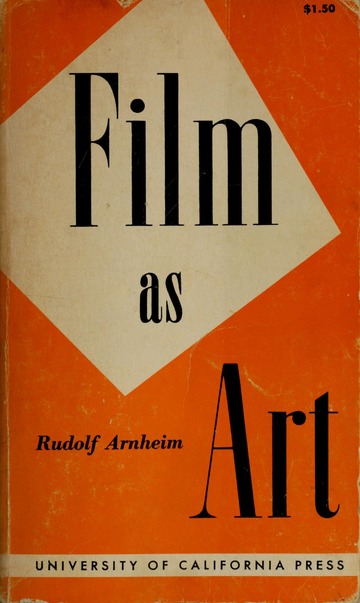Rudolf Arnheim: Film as Art (1932/1957)
Filed under book | Tags: · chronophotography, cinema, film, film sound, film theory, montage, photography, silent cinema

“This is a book of standards, a theory of film. The greater part of it is an adaptation of “Film als Kunst,” first published in 1932 in the original German and in English by Faber and Faber in 1933 – an edition long out of print but still in demand because it raises fundamental questions that the intervening years have by no means answered. This edition expands the original translation by four essays.”
Originally published as Film als Kunst by Ernst Rowohlt, Berlin, 1932.
Publisher University of California Press, 1957
ISBN 0520000358, 9780520000353
230 pages
Alexander Kluge: Raw Materials for the Imagination (2012)
Filed under book | Tags: · art, cinema, documentary film, experimental film, film, film theory, opera, politics, public sphere, television

“Alexander Kluge is best known as a founding member of the New German Cinema. His work, however, spans a diverse range of fields and, over the last fifty years, he has been active as a filmmaker, writer and television producer. This book – the first of its kind in English – comprises a wide selection of texts, including articles and stories by Kluge, television transcripts, critical essays by renowned international scholars, and interviews with Kluge himself. It will be a valuable resource for students and scholars in the fields of film, television, and literary studies, as well as those interested in exploring the intersections between art, politics, and social change.”
Edited by Tara Forrest
Publisher Amsterdam University Press, 2012
Film Culture in Transition series
Creative Commons BY-NC-ND 3.0 License
ISBN 9089642722, 9789089642721
440 pages
PDF (15 MB)
Comment (0)Gilles Deleuze: Cinema 2: The Time-Image (1985–) [FR, ES, EN, RU]
Filed under book | Tags: · cinema, film, film theory, image, montage, perception, philosophy, time

Cinema 2: The Time-Image brings to completion Gilles Deleuze’s work on the theoretical implications of the cinematographic image. In Cinema 1: The Movement-Image, Deleuze proposed a new way to understand narrative cinema, based on Henri Bergson’s notion of the movement-image and C. S. Peirce’s classification of images and signs. In Cinema 2, he explains why, since World War II, time has come to dominate film: the fragment or solitary image, in supplanting narrative cinema’s rational development of events, illustrates this new significance of time.
Deleuze ascribes this shift to the condition of postwar Europe: the situations and spaces “we no longer know how to describe”—buildings deserted but inhabited, cities undergoing demolition or reconstruction—and the new race of characters who emerged from this rubble, mutants, who “saw rather than acted.” Deleuze discusses the films of Rossellini, De Sica, Fellini, Godard, Resnais, Antonioni, Pasolini, Rohmer, Ophuls, and many others, suggesting that contemporary cinema, far from being dead, is only beginning to find new ways to capture time in the image.
Publisher Minuit, Paris, 1985
379 pages
English edition
Translated by Hugh Tomlinson and Robert Galeta
Publisher University of Minnesota Press, 1989
ISBN 0816616779, 9780816616770
364 pages
Publisher (EN)
Cinéma 2. L’Image-temps (French, 1985; added 2015-7-17)
Estudios sobre cine 2: La imagen-tiempo (Spanish, trans. Irene Agoff, 1987)
Cinema 2: The Time-Image (English, trans. Hugh Tomlinson and Robert Galeta, 1989)
Кино: Образ-движение (Russian, trans. Олег Аронсон, 2004, updated on 2013-9-26)
See also Volume 1
Comment (0)
